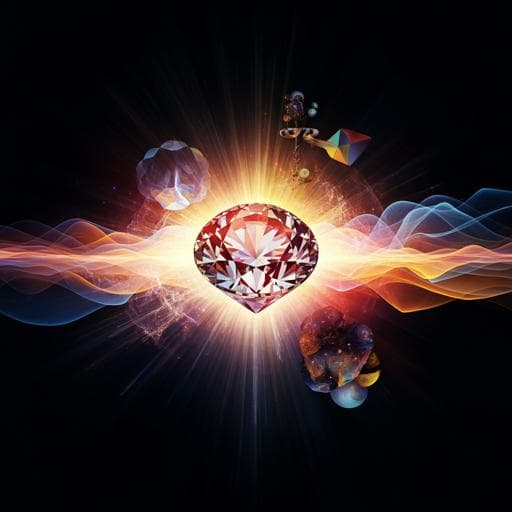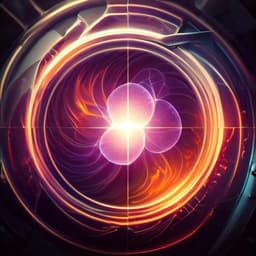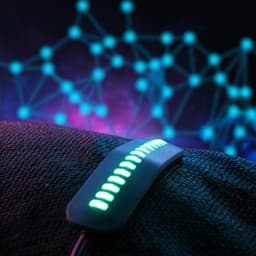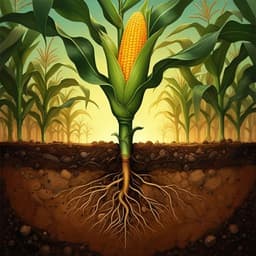
Physics
Microwave mode cooling and cavity quantum electrodynamics effects at room temperature with optically cooled nitrogen-vacancy center spins
Y. Zhang, Q. Wu, et al.
Discover groundbreaking advancements in microwave mode cooling and cavity quantum electrodynamics (C-QED) at room temperature using optically cooled NV spins. The research conducted by Yuan Zhang and colleagues reveals a significant reduction in microwave photon numbers and introduces potential for controlled C-QED effects under varying laser conditions.
~3 min • Beginner • English
Introduction
The work targets room-temperature cooling of a microwave resonator mode and the realization of cavity QED effects using optically cooled NV center spin ensembles. NV centers offer long spin coherence at ambient conditions with optical initialization and readout, enabling sensing and quantum information applications. Prior demonstrations cooled a 2.87 GHz resonator from 293 K to 188 K using optically polarized NV ensembles and observed room-temperature C-QED with pentacene molecules. However, NV-based mode cooling was limited by weak spin–resonator coupling, large spin dephasing, and high thermal occupancy at low microwave frequencies. The authors propose a setup using a higher-frequency 9.22 GHz dielectric resonator with lower photon damping, reducing thermal photon number and thermalization rate while enhancing spin–photon energy transfer. This aims to substantially improve mode cooling and enable room-temperature C-QED phenomena such as Rabi oscillations and vacuum Rabi splitting with NV ensembles.
Literature Review
The study builds on NV center applications in sensing and quantum information, previous benchtop microwave-mode cooling using hyperpolarized NV diamond at 2.87 GHz, and room-temperature C-QED observed with pentacene triplet spins. It references the continuous-wave diamond maser operating at 9.22 GHz and works on collective effects, superradiant lasing, and rate processes (spin-lattice relaxation and dephasing) in NV centers. It also connects to theoretical treatments of collective spin states (Dicke states) and suggests isotopic purification to increase NV density while maintaining dephasing, as indicated in prior materials studies. A contemporaneous preprint reports experimental laser-power-controlled microwave mode cooling and Rabi splittings with NV ensembles, aligning with the present theoretical predictions.
Methodology
The authors formulate a multi-level Jaynes–Cummings model incorporating the NV center’s triplet ground state (|1⟩=m_s=0, |2⟩=−1, |3⟩=+1), triplet excited state (|4⟩,|5⟩,|6⟩), and an effective singlet state |7⟩ representing 1A1/1E. The Hamiltonian includes the spin transition |1⟩↔|3⟩ at ω31 resonantly coupled to a single microwave mode at ωm via H_NV−m with coupling g31, the resonator Hamiltonian H_m, and a coherent microwave drive with strength Ω at frequency ω_a. Dissipation is modeled with Lindblad terms: optical pumping and stimulated emission between ground and excited triplet states with rate E (set by laser power), spontaneous emission from excited to ground triplet with rate κ_p, inter-system crossing between triplet excited and singlet (k_47, k_57, k_67, and k_71, k_72, k_73), spin-lattice relaxation between ground triplet spin sublevels (k_31, k_13≈k_31; k_12, k_21≈k_12), dephasing of m_s=±1 sublevels (χ_2, χ_3), and cavity thermalization with photon decay rate κ and thermal occupancy n_th(T). The master equation is solved using a second-order mean-field (cumulant expansion) approach implemented with QuantumCumulants.jl, exploiting permutation symmetry to simulate ensembles up to trillions of NV centers. Tracked quantities include level populations ⟨σ_i^z⟩, mean photon number ⟨a†a⟩, spin–photon correlations ⟨a†σ_i^z⟩, and spin–spin correlations ⟨σ_i^z σ_j^z⟩. An effective mode temperature T_mode is defined from ⟨a†a⟩. For analytical insight, spin–spin correlations are neglected and spin–photon correlations adiabatically eliminated to derive rate equations for level populations and intracavity photons, revealing the roles of thermalization κ n_th, energy transfer rate κ_eet (∝ N g^2 / x with x=κ+2χ_3), and ground-state population difference (σ^11−σ^33). Simulations assess pulsed and continuous laser excitation, and explore laser-power-controlled collective coupling using Dicke-state parameters J and M inferred from multi-level populations and correlations or approximate formulas in the two-level subspace.
Key Findings
- Mode cooling: Using a 9.22 GHz resonator with κ≈1.88 MHz and parameters from diamond maser experiments, the model predicts a minimum steady-state intracavity photon number of ~261, corresponding to T_mode≈116 K—about five times lower photon number and 72 K lower temperature than prior NV-based cooling at 2.87 GHz (188 K).
- Dynamics vs. rate equations: Full multi-level JC with second-order correlations yields a higher final photon number than simplified rate equations (261 vs. 307 photons minimum reported in different contexts; rate-equation effective temperature ~136 K), indicating that spin–spin correlations degrade cooling slightly compared to uncorrelated rate models.
- Scaling with ensemble size: Increasing NV count by 40× to N≈1.6×10^15 (as in some experiments) improves cooling to ~71 photons, T_mode≈32 K.
- Laser power dependence: Spin polarization from m_s=±1 to m_s=0 increases markedly above ~100 Hz optical pumping (~0.091 W), saturating near ground-state populations σ^11≈0.73 and σ^22≈σ^33≈0.13 around E~10^5 Hz (~100 W). The photon number drops strongly with increasing laser power up to ~100 W, reaching its minimum near E~10^5 Hz, and then increases slightly at higher power due to excited-state population buildup (saturation effects).
- Collective coupling and C-QED: The ensemble’s collective symmetry (J/N) grows with laser power and saturates around J/N≈0.35, preventing access to fully symmetric J=N/2 states. For N=4×10^13, the estimated collective coupling √(2J)g≈2×0.57 MHz is just below the dephasing rate χ_3=2π×0.64 MHz, i.e., near the edge of strong coupling. With isotopically purified diamond enabling N≈4×10^14, the coupling increases to √(2J)g≈2×1.8 MHz, exceeding χ_3, enabling strong coupling at room temperature.
- Rabi signatures: Time-domain measurements with a 5 µs microwave pulse show a transition from monotonic saturation to oscillatory dynamics as laser power increases (0.01 W → 1–10 W), with oscillation frequency increasing and then saturating at high power (100 W). Frequency-domain steady-state spectra evolve from a single resonance to a doublet with increasing laser power; Rabi splitting Δ grows with power and then saturates due to optical saturation of the NV transitions.
- Practical considerations: Higher resonator frequency reduces n_th and κ n_th, and increases spin–photon energy transfer via larger g. Saturation and thermal effects at high laser power can limit performance; diamond cooling can mitigate optical heating.
Discussion
The results show that by elevating the resonator frequency and reducing photon damping, while optically polarizing the NV ensemble, the thermalization pathway is suppressed and energy extraction into the spin ensemble is enhanced, enabling substantial cooling of a microwave mode below ambient temperature in a benchtop setup. The incorporation of full NV level structure and correlations clarifies realistic limits from saturation and dephasing. Laser power acts as a control knob for spin polarization and collective symmetry (J), thereby tuning the collective coupling strength and enabling room-temperature C-QED phenomena, including observable Rabi oscillations and vacuum Rabi splitting when the ensemble size and coupling are sufficient. These advances are relevant for quantum sensing, microwave quantum thermodynamics, and potential quantum information processing at room temperature. The framework generalizes to other solid-state spin systems and to maser-related C-QED regimes.
Conclusion
The study proposes and analyzes a high-frequency NV–microwave resonator platform that achieves stronger spin–photon coupling and reduced thermal loading, enabling deeper benchtop cooling of a microwave mode (to ~116 K, potentially ~32 K with larger ensembles) and room-temperature C-QED signatures controlled by laser power. A multi-level, correlation-aware model captures optical pumping, inter-system crossing, and dephasing, and predicts weak-to-strong coupling transitions and saturation-limited Rabi dynamics. Future work should optimize NV density and isotopic purity to increase N and reduce dephasing, engineer higher g and lower κ resonators, mitigate optical heating, and extend the model to include nuclear spins and explore pulsed/continuous maser operation under C-QED conditions.
Limitations
- Optical saturation at high laser powers limits achievable spin polarization, collective symmetry (J), and thus collective coupling and Rabi splitting.
- Potential optical heating of the diamond at high powers may degrade cooling performance; active thermal management is required.
- The model uses a single dephasing rate and assumes identical parameters across all NV centers, simplifying inhomogeneous broadening and environmental variability.
- Rate-equation approximations neglect correlations and can overestimate cooling; while full cumulant treatment is more accurate, it still truncates higher-order correlations.
- Achieving strong coupling at room temperature may require increased NV numbers, improved resonator coupling, or reduced dephasing beyond current samples.
Related Publications
Explore these studies to deepen your understanding of the subject.







